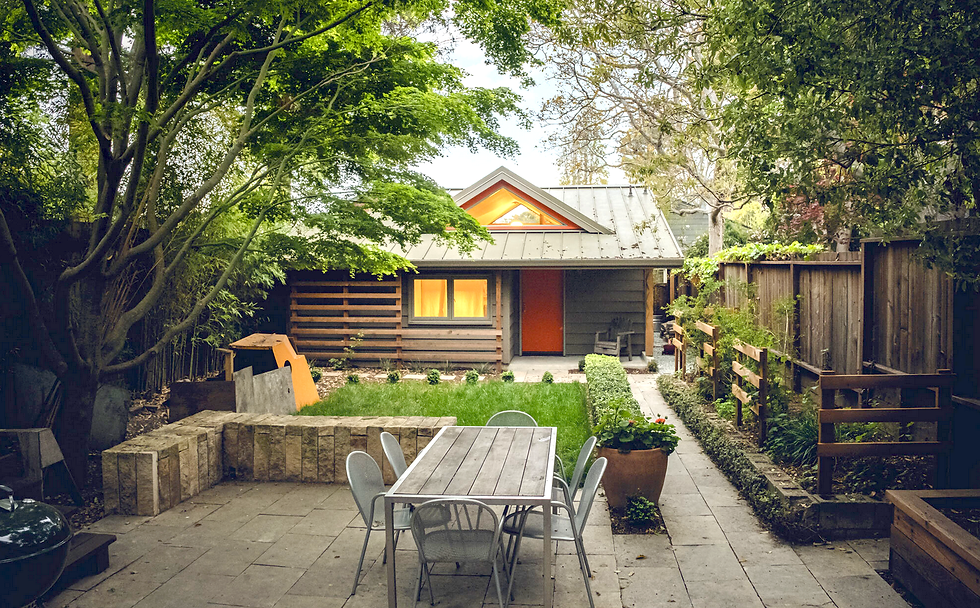Net Positive in Berkeley
- wbdesignloop
- Jul 1, 2021
- 4 min read

By Scott McGlashan
McGlashan Architecture - Original and Ecological Design and Planning
It has become a mantra among forward thinking energy geeks: To meet our energy goals, we need to stop burning natural gas and go all electric. With a car, it’s pretty easy to understand how to go all electric, but it’s a bit more complicated when it comes to converting a normal existing house into an all electric one. The home systems that traditionally burn natural gas (heating the house, cooking, water heating, clothes drying) are central to our comfort, health, and happiness; so it’s worth careful design and thoughtful planning to get them to fit just right.
McGlashan Architecture was hired by a Berkeley family to add second story bedrooms and a modern kitchen to their traditional bungalow. The owners are committed professional environmentalists and from the earliest stages of planning were driven to design a low carbon house. We knew we’d be successful if we could cap off the natural gas line, give the gas meter back to PG&E, and never pay another gas bill. Sometimes the best place to stop burning hydrocarbons is at home.
The first design move was to shape the roof around solar access. Since we were adding the second story and there was little shading from trees or neighbors, we could shape the roof around two main concerns: It had to both sit comfortably with the design of the existing house, and support solar panels at an ideal angle. We routed all the roof vents and penetrations to leave clear space for the solar panels. As the solar installer from A1 Sun said when he first saw the roof, "Finally a roof surface that is truly ‘solar ready!’ Facing south…one big flat plane…no shade, no vents, no skylights, no chimneys, no hips, no valleys, no crickets… a well thought out surface and at a decent azimuth and slope. Those roofs should be on every home!”
With the help of Beyond Efficiency, a leading green building consultant based in Berkeley, McGlashan Architecture and the owners carefully developed window orientations, framing details, insulating strategies, and roof overhangs so that the house would require as little heating, cooling, and artificial lighting as possible. We installed a sophisticated Sanden heat pump system that uses a single outdoor compressor to provide both warm air to the existing registers and hot water to the plumbing. An innovative system like this requires careful coordination between the manufacturer, the system designer, the owner, the architect, the contractor, the plumber, and the HVAC installer. The extra work is worth it when the end result is a quiet, efficient, reliable, and properly sized system that burns no gas. The kitchen was central to the vision for the whole project. Cooking and eating together is at the center of the owners’ family life. We designed a generous kitchen for a serious cook, which serves as a gathering place to connect the main rooms of the house with the back deck and their rear yard of trees and Bay breezes. Well-laid-out spaces, wide countertops, and carefully considered lighting and storage make for a pleasurable cooking experience. We even fine-tuned the spacing of the slats on the deck trellis to make it comfortable to wash dishes while the sun sets in the evening. Large windows reach all the way down to the countertop, and in good weather, they can fold wide open to offer a dramatic and unobstructed connection to the outdoors. The deck trellis supports a glass roof that keeps the whole area dry, a gracious connection between inside and out that begs to be at the center of a bustling house party. To eliminate the gas cooktop, we installed an induction range. In a modern kitchen, an induction cooktop is an easy choice: as fast as gas, with instantaneous control, and much less indoor air pollution. They’re about 85% efficient compared to a gas cooktop which is about 35% efficient. Sometimes you have to upgrade the electrical service, and not all pots and pans work well, but I’ve been almost insisting that my clients consider an induction cooktop when doing a kitchen project. A few months of cooking with one creates lifelong converts, especially among serious cooks. TIP: You can now borrow an induction cooktop from the Berkeley Tool Lending Library. Type "INDUCTION" into the "TOOL FINDER" to place a hold. You can choose from either an "induction cooker" (if you already have induction cookware) or choose the "induction cooktop set" which comes with induction compatible stainless steel fry and sauce pans.

After over a year of use, with the whole family of four living and working at home during the pandemic, we can call the project an indisputable success. Despite adding an entire second story, the house now uses ~40% less energy than it did before the expansion (due to increased insulation and more efficient heating and lighting) and the solar panels generate ~50% more electricity than the house consumes, even including the charging of an electric car. The energy bill for the first year one was negative $914! The utility company pays the owners 9 months out of 12! We’re proud to be filling in our neighborhoods with houses that are inexpensive to live in, look great, feel comfortable, fit the environment, and contribute energy to the rest of California. local Berkeley folks:
contractor: Oliver Builders Inc
engineering: Verdant Structural Engineering
energy/green building consultants: Beyond Efficiency
cabinets: Mod Cabinetry
photovoltaics: A1 Sun, Inc












Comments